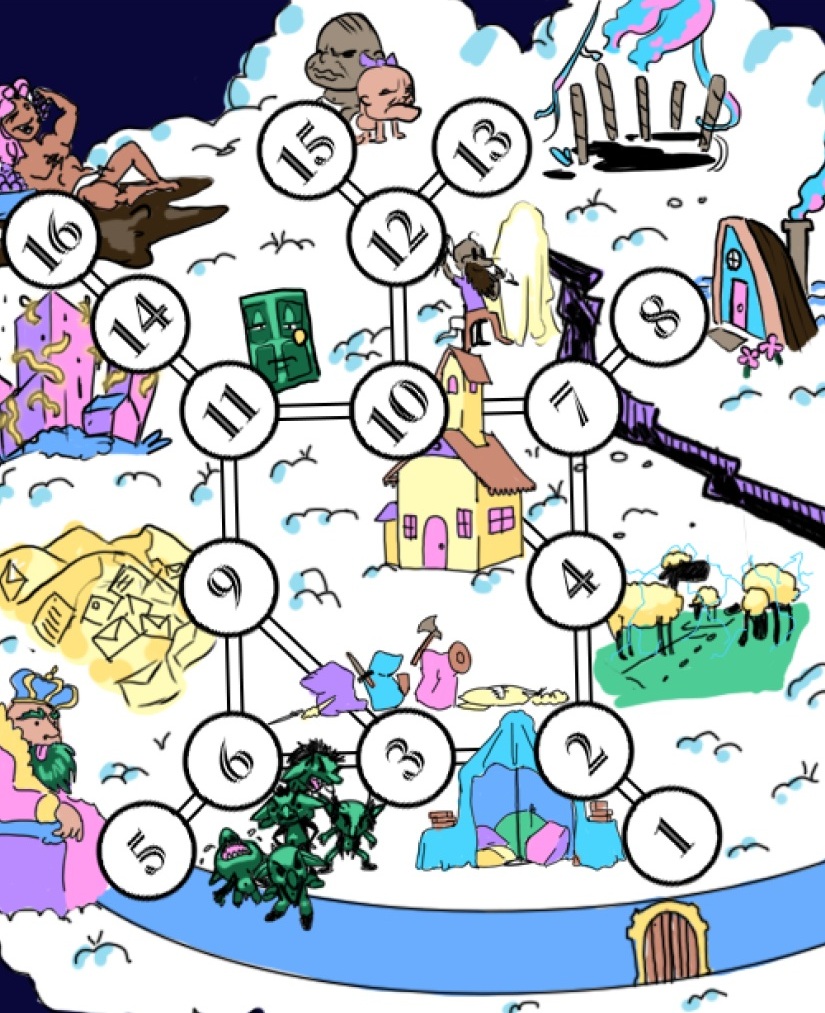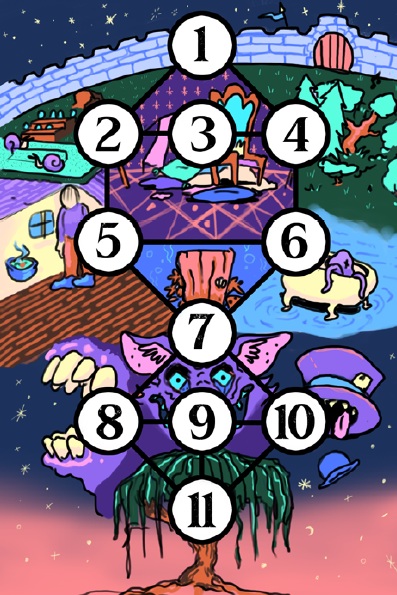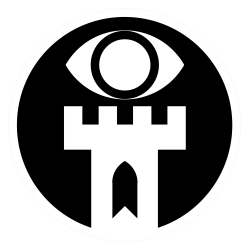When I design a TTRPG map, I try to center one easy question: what are the choices?

Now there’s a million ways to do this, and I don’t really think any of them are wrong. If you’re looking for the canon wisdom, check this (nomenclature-challenged) article on Jacquaysing.
My Way
If you’re looking for non-canon wisdom, you’re in the right place! Here’s my ‘process’ – or at least the process I was using back when Trouble with Dreams, Kiss to Build a Dream On, and Wake Up Sheeple were coming out.
STEP ONE: Draw a bunch of circles, one for each encounter/zone.
STEP TWO: Draw lines between those circles, one for each path. This gives you a nice flow chart map.
STEP THREE: Colour in all circles with three lines (or more!) attached to them.
STEP FOUR: Do it all again! Produce several maps.
STEP FIVE: Pick the one with the most coloured circles (other criteria may apply).
Why three lines? Because a zone attached to three paths is a choice zone. Players walk in through path one, deal with the local trouble, and then choose between path two or three.
Why do you want choice zones? Because Agency (capital A) is at the heart of the game. Your players’ fondest memories of your campaign are invariably going to be the time they jumped the rails, ignored your prep, and struck off on some zany side mission.
Why? Because they chose that adventure.
What is Choice?
But it’s not enough to just have three paths leading away from every zone. There’s an important difference between having a choice and having options. When I run prewritten modules, I can’t tell you how often my players come to a choice between two doors and just don’t know where to go.
“Do the doors look different?”
Uh, it doesn’t say. Probably not really?
“Are there any signs or glyphs?”
No, ma’am.
“Can we hear anything if we listen at the door?”
Hold on, let me flip ahead to those rooms and see if there’s anyone in there.
To make an option into a choice, you need information. You need to be making an informed decision. Otherwise, it’s not a choice; it’s a coin flip. In the absence of real choices, the door is open for all sorts of Quantum Ogres and other ‘bad’ forms of Game Mastery.
So, doors have signs, even if they’re outdated ones in hard-to-decode languages. Things smell. Sounds travel through doors. Knobs are either hot or cold. The wind blows underneath doors near outside passages and heat sources. Players often get half-maps at the beginning of adventures.
Easy.
The Trouble With Dreams
How do we apply this to adventures without doors?
Well, in two-pagers like the Trouble with Dreams, there’s not a ton of space to encode this information, but that doesn’t mean you shouldn’t try it. When players looked down paths in playtests, I’d give them strange glimpses and hints at what lay beyond. In case you’re interested in trying the adventure, I’ve collected those hints/visions here; if you’re running your own surreal adventures, check these out as guides and inspirations for how you might entice players down various paths.

1 Landing Zone
Seen from Zones 2 or 3, the Landing Zone appears to be an imposing, massive wall.
2 Snail Jousts
Strange, ever-shifting heraldry is displayed on banners waving over a seething jumble of riser seating.
3 The Dreaming Throne
The Dreaming King can be seen sitting on his throne. His feet are half-buried in the earth; his massive face peers down from the sky. The titan’s glowing eyes survey this whole realm. He gets smaller as you get closer. By the time you enter the zone proper, he is the child-sized deity described in the module.
4 Forest that’s also a Church
You can hear the sounds of hymns and jingling coins filtering out from the forest in this direction.
5 Home
Is that your childhood home in the distance? If a PC brings it up in conversation, make sure they understand that they’re each seeing their individual home; everyone sees something different.
6 Bathtub Graveyard
What appears from a distance to be small mounds of white shining stone are accompanied by the smell of seawater.
7 Ocean at your Door
A massive door erupts from the dreamscape. The smell of seawater drifts in on dream winds.
8 Falling Teeth
Chattering teeth, crying, and cruel laughter can be heard coming down this narrow hallway.
9 Hunted Hall
The barking of mad dogs and the rolling of dice echo through the passages connected to this zone.
10 Hungry Haberdashery
No sounds, but a pleasant, almost leathery smell drifting on the air.
11 Recursive Waking
Total silence. The only lacuna on this map. What could be down this passage?
So there you have it! Some principles of TTRPG Map Design, accompanied by a little example that should make playing the Trouble with Dreams a little more fun/easier. If you like this, check out our DMing tips. We’ve also got a Sumo Wrestler class for Old School Games, as well as a fun Goblin Labyrinth Depth Crawl for Troika. Like what you see? Throw us some spare change and buy the Trouble with Dreams for your table!
